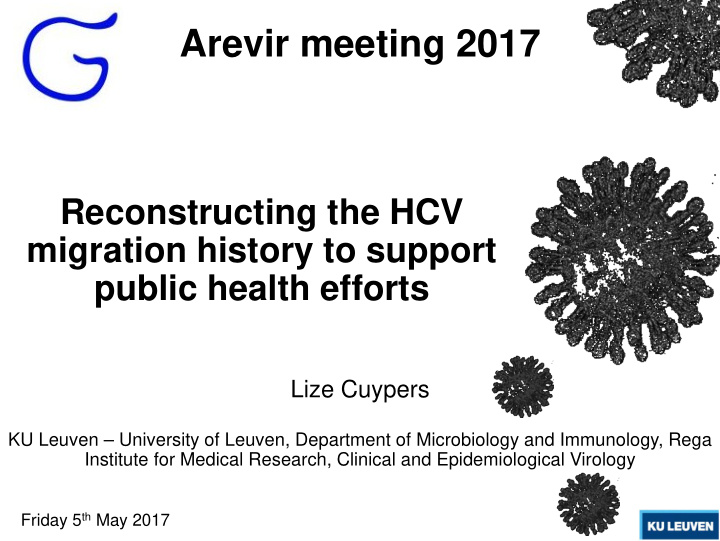



Arevir meeting 2017 Reconstructing the HCV migration history to support public health efforts Lize Cuypers KU Leuven – University of Leuven, Department of Microbiology and Immunology, Rega Institute for Medical Research, Clinical and Epidemiological Virology Friday 5 th May 2017
Hepatitis C: the silent killer • Globally 80 million people currently infected • Majority develops chronic infection: risk for liver- associated diseases • High genetic diversity: 7 genotypes, >50 subtypes => HCV1a, 1b and 3a most prevalent Normal Liver Chronic Hepatitis Cirrhosis HCC 2 2 Adapted from Hepatitis C online From Cuypers L, et al. Rev Med Virol. 2016
Antiviral treatment: DAAs •Major evolution in the HCV antiviral treatment field •Variants naturally produced or emerging under therapy: resistance-associated substitutions (RASs) DAA + IFN DAAs IFN >95 90-95 >95 89-100 83-96 100 S VR (% ) 70-80 80 50-60 60 40 <30 2015 2016 2014 2017 2011 2013 20 Peg- IFNα + 0 S imeprevir Daclatasvir Telaprevir HCV GT1 Grazoprevir ABT-493 + IFN Velpatasvir S ofosbuvir (+RBV) Boceprevir Ledipasvir ribavirin Elbasvir ABT-530 Paritaprevir 2001 Dasabuvir Ombitasvir NS5A inhibitors NS3/4A protease NS5B polymerase inhibitors inhibitors 3
In-depth phylogeography • Interpretation of impact RAS on DAA treatment => expanding sequencing efforts • Temporal and geographical dimensions of sequences to reconstruct the virus migration history => public health policy • Bayesian phylogenetic inference: - Ancestral reconstruction in time and its relation with amino acid usage patterns - Inferring patterns of spatial spread: migration rates between locations 4 4
Mapping the importance of NS3 variant Q80K in the current Italian HCV1a epidemic 5
NS3 RAS Q80K •High natural prevalence in HCV1a (Cuypers et al . Viruses 2015 – Cuypers et al . Virus Evolution 2016) •Interference with action of NS3/4A protease inhibitor simeprevir •High HCV burden in Italy •Dataset: new Italian sequences supplemented with data from Genbank Adapted from European centre for disease control and 6 prevention - From Cuypers L, et al. Rev Med Virol. 2016
Timing and origin Q80K •HCV1a variability: two clades - Q80K in clade I Q80K NS3 80 •Single origin in US •Introduction Q80K Clade I in Italy: 1961.5 (95% HPD: 1957.6-1965.7) •Similar migration patterns in Clade II different clades 7 From Cuypers et al . BMC Evol Biol 2017
Migration patterns •Seeding role of US to Italy and Europe •Continental HCV1a circulation gained importance •Italy exports to other European countries •Within-Italy: no local sub epidemics for North, Central and South Italy 8 From Cuypers et al . BMC Evol Biol 2017
Genotyping strategy Q80K in Italy •Both immigration and national circulation of NS3 variant Q80K fuel the Italian HCV1a epidemic •Public health strategy: test all HCV1a infected patients eligible for simeprevir based therapy for the absence of variant Q80K 9
Vrancken, Cuypers, Pérez, et al . Frequent de novo generation of HCV3a resistance-associated subsitutions in Spain. 15th European Meeting on HIV & Hepatitis, Rome, Italy, June 2017. Poster #79 Frequent de novo introduction of HCV3a NS5A variant Y93H in Spain 10 Vrancken et al . Manuscript in preparation
NS5A variant Y93H •HCV3a: difficult-to-treat and highly prevalent •Therapy: NS5A + NS5B inhibitors => RAS •NS5A and NS5B sequences: Spain + Genbank •NS5A RAS Y93H overrepresented in Spanish strains • De novo generation on external branches => Spain: ‘host-spot’ region of Y93H 11
Indian subcontinent as HCV3a origin •Earliest strains sampled in Pakistan, India and the UK: around 1934 (95% HPD: 1909.3 - 1950.9) •NS5A RAS A30L dominant role in Pakistanian strains •Other NS5A and NS5B RASs no clear pattern 12
What not went in - cannot come out •Strengths and intensities of migration links between locations (both countries and regions) vary between NS5A and NS5B data 13 Anglosphere backbone European backbone
Combined phylogeography •Spain acts as a sink for HCV3a: import from Germany (NS5A) <-> UK (NS5B) •Export from Spain towards Europe and Anglosphere •NS5A – NS5B: different sample from the epidemic <-> combined: complementary picture of migration •Use data from multiple genomic regions (longer fragments!) – need for broader sampling strategies 14
Migration patterns of NS3 and NS5A RAVs in the European HCV1a epidemic 15
HCV1a European migration •Q80K study in Italy: - sample size: number of taxa per country - number of European countries - NS3: one fragment - poor phylogenetic signal •HCV3a study in Spain: - NS5A and NS5B: complementary picture - what not went in, cannot come out: small sample => large European HCV1a study: taxa – countries => multiple regions: NS3 and NS5A 16
HCV1a European study NS3 – NS5A •Dataset compilation and QC: NS3 = 2514 taxa - NS5A = 1957 sequences (with location and date) •Prior estimation of the evolutionary rate using full- genome strains •Analyses ongoing for NS3 and NS5A 17
Acknowledgments • Clinical and Evolutionary Virology – KU Leuven, Belgium Anne-Mieke Vandamme Kristel Van Laethem Bram Vrancken • Hepatology department UZ Leuven, Belgium Frederik Nevens • University Tor Vergata, Rome, Italy Francesca Ceccherini-Silberstein - Lavinia Fabeni – Valeria Cento – Velia Chiara Di Maio • San Cecilio University Hospital, Granada, Spain Féderico Garcia – Ana Belen Perez • Institute for Virology, University Cologne, Germany Rolf Kaiser – Saleta Sierra-Aragon • J.W. Goethe University Hospital, Frankfurt, Germany Christoph Sarrazin • Institute of Infection and Global Health, University of Liverpool, UK Anna Maria Geretti, Apostolos Beloukas • University College Dublin, Ireland Martha Neary • Pomeranian Medical University, Szczecin, Poland Milosz Parczewski • Clinical Microbiology, Egas Moniz Hospital, Lisbon, Portugal Perpétua Gomes • Central Research Institute of Epidemiology, Moscow, Russia Vladimir Chulanov 18
Recommend
More recommend